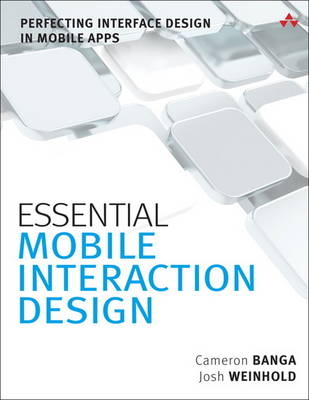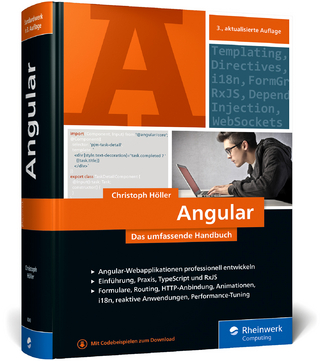
Essential Mobile Interaction Design
Addison-Wesley Educational Publishers Inc (Verlag)
978-0-321-96157-0 (ISBN)
- Titel ist leider vergriffen;
keine Neuauflage - Artikel merken
Mobile apps should feel natural and intuitive, and users should understand them quickly and easily. This means that effective interaction and interface design is crucial. However, few mobile app developers (or even designers) have had adequate training in these areas. Essential Mobile Interaction Design fills this gap, bringing together proven principles and techniques you can use in your next app–for any platform, target device, or user.
This tutorial requires virtually no design or programming knowledge. Even if you’ve never designed a mobile app before, this guide teaches you the key skills that lead to the best results. Cameron Banga and Josh Weinhold help you master the mindset, processes, and vocabulary of mobile interaction design, so you can start making better choices right away. They guide you through the entire design process, demystifying issues that arise at every stage.
The authors share hard-won lessons from years of experience developing more than one hundred mobile apps for clients and customers of every type. They cover important issues that platform-specific guides often overlook, including internationalization, accessibility, hybrid apps, sandboxing, and what to do after release.
This guide shows you how to
Think through your designs, instead of just throwing together UI elements
Allow an intuitive design flow to emerge from your app
Sketch and wireframe apps more effectively
Reflect key differences among smartphones, tablets, and desktops
Design for visual appeal without compromising usability
Work effectively with programmers
Make sure your apps are accessible to everyone
Get usable feedback, and understand what it’s telling you
Learn valuable lessons from today’s most successful apps
Refresh your designs in new apps and future versions
Discover new tools for designing more successfully
Packed with iOS and Android™ examples, Essential Mobile Interaction Design offers dozens of tips and solutions that will be equally useful on today’s platforms and on whatever comes next. Extensive resources are available at cameronbanga.com/EMIDbook.
Cameron Banga is lead designer at 9magnets LLC, a company he cofounded. He has worked on more than one hundred mobile apps for clients ranging from pro sports teams to educators to large corporations. His first application, Battery Go!, quickly became an iPhone best seller. His apps have been recommended by the New York Times, Fox Business News, Macworld, PC Magazine, and many other media outlets. Josh Weinhold is assistant editor of the Chicago Daily Law Bulletin and Chicago Lawyer magazine. He shared a National Press Club Online Journalism Award with other members of an msnbc.com/Elkhart Truth reporting team, and won The Chicago Bar Association’s Herman Kogan Award for legal beat reporting.
Preface xvii
Acknowledgments xix
About the Authors xxi
Chapter 1: A Look at Mobile and Its Main Players 1
The Field of Interface Design 2
The Dawn of the App 3
What Is a Mobile Device? 8
The Industry’s Key Players 12
Distinctions between Platforms 16
Conclusion 19
Chapter 2: Design for Humans, by Humans 21
What Is Interaction Design? 22
Goals When Designing an Interface 25
Designing for Humans 25
Designed by Humans 28
Where to Begin 30
Anticipating Your User Base 32
Mobile’s Role in User Workflow 35
Conclusion 37
Chapter 3: Dynamic Differences in Mobile Design 39
Understanding the Role of Mobile 40
Mobile-Only Interactions 41
Interactions That Aren’t Possible on Mobile 46
Universal Appeal 48
Complementing Traditional Workflows 55
Conclusion 57
Chapter 4: First Sketches of an App 59
What Tools Do You Need? 60
Becoming a Designer 65
Planning for a Specific Platform 66
Starting with a Workflow 68
Creating Pixel-Perfect Digital Mockups 73
Reiterating Before It’s Too Late 75
Preparing for the Next Stage 77
Conclusion 79
Chapter 5: Finding the Right Design Flow 81
The Big Three App Types 82
Common App Navigation Methods 85
Picking an Interaction Type 93
Minimizing Interface Friction 96
Preparing for Connectivity Failure 98
Conclusion 102
Chapter 6: Designing for Visual Appeal 103
How Appearance Changes Interactions 104
Creating an App Icon 107
Finding a Unique Look 111
Matching Art to Interaction Design 115
Building Art That Scales 119
Adding the Final Touches 123
Conclusion 126
Chapter 7: Working with Programmers 127
Understanding Your Programmer 128
Describing Your Design 132
Communicating During Development 136
Comprehending the Source Code 141
Conclusion 148
Chapter 8: Making Apps Usable by All 149
Knowing Your Audience 150
How Sandboxing Changed Mobile 152
Interactions for the Mass Market 157
Building Multilingual Interaction Designs 160
Designing for Users with Disabilities 163
Conclusion 166
Chapter 9: Designing for Simplicity 167
The Sophistication of Simplicity 168
Simple Design Goals 171
Interfaces That Do It Well 175
Creating Simple Interactions 178
Simplicity through Familiarity 183
Testing Simplicity 186
Conclusion 191
Chapter 10: Gaining Valuable Feedback 193
Showing Off Your Work 194
Devising a Beta-Test Strategy 198
Analyzing Valuable Test Data 204
From Beta to Positive Changes 208
Conclusion 211
Chapter 11: Refreshing a Design 213
Improving as a Designer 214
Judging Who Is Worth Listening To 218
Turning Requests into Changes 224
Preparing Users for Design Changes 226
The Resubmission Process 228
Conclusion 230
Appendix A: Standout Apps 231
1Password 232
Amazon Mobile 232
CNN News 233
Coach’s Eye 234
Evernote 234
Facebook 235
Flipboard 236
Google Chrome 237
Google Maps 237
Instagram 237
Instapaper 239
MLB.com At Bat 240
Twitter 240
TuneIn Radio 241
Wolfram|Alpha 242
Appendix B: Apps for Designers 243
Adobe Photoshop 244
Balsamiq 244
Bugshot 245
Dribbble 246
Icon Slate 247
MindNode Pro 247
Pngyu 248
Skitch 249
Spark Inspector 249
xScope 249
Appendix C: Artwork Requirements for Android and iOS 251
Android 252
iOS 255
Index 261
| Erscheint lt. Verlag | 10.4.2014 |
|---|---|
| Verlagsort | New Jersey |
| Sprache | englisch |
| Maße | 179 x 227 mm |
| Gewicht | 474 g |
| Themenwelt | Mathematik / Informatik ► Informatik ► Grafik / Design |
| Mathematik / Informatik ► Informatik ► Netzwerke | |
| Informatik ► Software Entwicklung ► Mobile- / App-Entwicklung | |
| Informatik ► Software Entwicklung ► User Interfaces (HCI) | |
| Informatik ► Weitere Themen ► Smartphones / Tablets | |
| Technik ► Nachrichtentechnik | |
| ISBN-10 | 0-321-96157-9 / 0321961579 |
| ISBN-13 | 978-0-321-96157-0 / 9780321961570 |
| Zustand | Neuware |
| Informationen gemäß Produktsicherheitsverordnung (GPSR) | |
| Haben Sie eine Frage zum Produkt? |
aus dem Bereich


